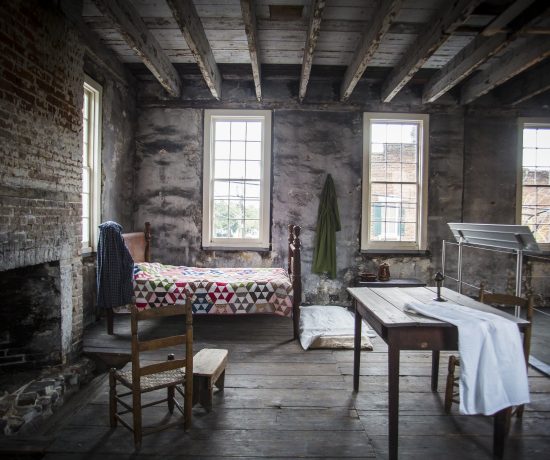14 million visitors flock to Savannah, Georgia looking for a dose of southern hospitality every year.1 There is no Savannah without manicured squares and expertly preserved homes, many operating as historic house museums.
There is also no Savannah without the slave economy and these museums are among the most accurate witnesses to slavery’s impact on the city.
Opened to the public in 1954, in 2018 the Owens-Thomas House and Slave Quarters (OTHSQ) completed a 20-year process to formally change its name and mission, now to “explore the complicated relationships between the most and least powerful people in the city of Savannah in the early 19th century.”2 Through this they have reframed their tour narrative and exhibits to focus on the enslaved. The OTHSQ is among a group of house museums beginning to confront their complex histories with slavery. Missions and programs vary, but the opportunity is for these vanguard institutions to challenge and reshape the category for more accurate visitor education and expanded civic dialogue and action on issues of race and equality.
The OTHSQ and its peers exist in the troubling duality of the American historical tourism economy where antebellum house museums serve to fetishize the trophies of slavery under the guise of historical preservation while broadly denying their relationship to the institution.
While many visitors have praised the OTHSQ for its effort to spotlight the enslaved, others have been shocked, even angered. Online reviews abound with comments like, “We never owned slaves and should not be made to feel that it’s “OUR fault” for the way slaves were treated.”3
1- and 2-star Google reviews reveal trends in visitors’ negative reactions, like “the entire tour is nothing but a guilt trip on “Whites”,”4 and “I welcome facts on the hardship of the slaves … but I don’t need / want to have ALL Upper Class historical figures ignored, vilified or removed to be P.C.” (sic.)5
The tangle of compassionate and critical sentiments in these review examples reflect the twin expressions of shame and egoic protection that often accompany racist dynamics when confronted.6 More importantly, they illuminate the lack of education on the essential role of the slave system in the economic growth of the U.S. The house museum category reinforces this blind spot. Instead of existing in public memory as evidence of the gains of slavery sites like the OTHSQ have been preserved and glorified as architecture, decorative arts and individual family assets. The minimizing of their reliance on slavery is achieved by removing physical and narrative cues, avoiding explicit ties between the site and slavery profits and downplaying the cruelty of the ownership class and realities of enslaved life. Visitors can walk away feeling comfortable that slavery was not directly tied to the owners’ success.7 As Simon suggests this public history “seeks to legitimate and secure particular social relations”8, in this case, the innocence of the white plantation class and therefor modern white visitors.
To leverage a helpful inversion of DeLucia’s and Kirshenblatt-Gimblett’s arguments, by largely not collecting the traces of slavery, these sites have helped to disappear the institution and the enslaved, to validate slave owner superiority and to reduce public accountability.9 Within this context, a tourist’s confusion or anger at the OTHSQ seems rational, for they are being immersed into an experience related to slavery that they have never believed is part of their own history.
The OTHSQ immersion is choreographed with a tour that starts at the slave quarters where a timeline hints at the parallel histories of the city, family and expansion of slavery. The slave quarter is sparsely outfitted and visitors learn that up to 15 enslaved persons worked and lived there. Throughout the house are rooms outfitted predictably with period furniture, artwork and decorative items while the narrative interweaves details about the enslaved. Once George Owens and the architecture would have dominated tour commentary but now tales of the more than 400 enslaved supporting this city house and its related plantation factor into the core programming. Exhibits leverage property records to bring the identities of the enslaved to life, including profiles of specific individuals. One compelling device is the projected image of a young woman in the cellar laundry, bringing the visitor into life-size contact.
In these ways, the OTHSQ effectively brings the enslaved out of disappearance into central historical view. But there are notable gaps that prevent a true re-writing of its legacy as a plantation-era house museum. The young washing woman, for example, isn’t holding the visitor’s gaze, allowing the visitor to take pity without being challenged to engage. Another lost opportunity is in not staging the slave quarters in parity to the main house rooms to help visitors imagine what it would have really been like for a dozen people to be bathing, dressing, sleeping, having sex, playing, laughing, dying in these close quarters.
While the museum’s pointed focus on the lives of the enslaved does dramatically shift the overall narrative toward a more central consideration of their experience, there is a negative impact to this approach. Relatively little content is aimed at explaining the larger institutional framework of the slave economy in which this house, this owner and these enslaved functioned. Without this context, slavery seems local, personal, exceptional and not structural which makes advancing education curriculum, dialogue and change on a civic level nearly impossible.
The most glaring problem with the OTHSQ experience is not found at the property itself, but in its failure to acknowledge the relationship to slavery of its owner foundation, the Telfair Museums. This philanthropic arts organization is named for a well-documented slave-holding family. The Telfair grant application to fund the OTHSQ project makes no mention of the Telfair family’s slave holding record in the lengthy description of the history and activities of the Telfair Museums.10The potential for the OTHSQ’s new mission to help the Telfair organization “check the box” while avoiding scrutiny on the broader source of the original funding for its founding art collections, buildings and philanthropic pursuits casts the OTHSQ’s efforts into darker light.
On its face the OTHSQ is taking a step in a useful direction but it largely succeeds in making slavery seem like a sad, past reality contained at its single property. Despite its strides, this site does not represent a radical reckoning with the legacy of the antebellum house museum. Nor does it challenge visitors to actively interrogate what Simon might have called the “terrible gift” of the inheritance of slavery to expand the public’s historical conscience via democratic engagement.11 The first step in this direction is arguably for the Telfair charitable organization to take public accountability for its own scarred history. Only when all such museum organizations reveal and reject their long-standing attachments to the slave economy will antebellum house museums be able to stop enabling the plantation fetish and start forging a more meaningful path forward as stewards of public discourse and action.
- Notes
- Savannah Area Chamber of Commerce, et al. Savannah 2021 Economic Trends. Savannah Area Chamber of Commerce, 2021.
- Sommers, Cyndi. Email to the author. 14 December 2020 and The Telfair Museums. “Owens-Thomas House and Slave Quarters.” 2022. https://www.telfair.org/visit/owens-thomas/.
- Review of the Owens-Thomas House and Slave Quarters. Trip Advisor. 2020, https://www.tripadvisor.ca/ShowTopic-g60814-i133-k12657461-o30-Terrible_experiece_at_Telfair_Museum-Savannah_Georgia.html.
- Clara Gasaway. Review of the Owens-Thomas House and Slave Quarters. Google. 2020.
- Dave and Katie Kuepfer. Review of the Owens-Thomas House and Slave Quarters. Google. 2019.
- Kirshenblatt-Gimblett, Barbara. “From Ethnology to Heritage: The Role of the Museum.” Museum Studies: An Anthology of Contexts, Second Edition, edited by Bettina Messias Carbonell, Blackwell Publishing Ltd., 2012, p.203.
- Tariro Mzezewa. The New York Times. “Enslaved People Lived Here. These Museums Want You to Know.” June 26, 2019.
- Simon, Roger I. “Museums, Civic Life, and the Educative Force of Remembrance.” Museum Studies: An Anthology of Contexts, Second Edition, edited by Bettina Messias Carbonell, Blackwell Publishing Ltd., 2012, p.93.
- Kirshenblatt-Gimblett, pp. 202-203. DeLucia, Christine. “Antiquarian Collecting and the Transits of Indigenous Material Culture: Rethinking “Indian Relics” and Tribal Histories.” Common-Place: The Journal of Early American Life, vol.17, no.2, winter 2017. Common-place.org/book/antiquarian-collecting-and-the-transits-of-indigenous-material-culture-rethinking-indian-relics-and-tribal-histories/, p.5.
- Telfair Museum of Art, Inc. The Owens-Thomas House: Interpreting the Dynamics of Urban Slavery in the South.Application for the National Endowment for the Humanities Public Humanities Projects, Historic Places Implementation Grant, 2021.
- Simon, Roger I. “Museums, Civic Life, and the Educative Force of Remembrance.” Museum Studies: An Anthology of Contexts, Second Edition, edited by Bettina Messias Carbonell, Blackwell Publishing Ltd., 2012, pp.94-95.

